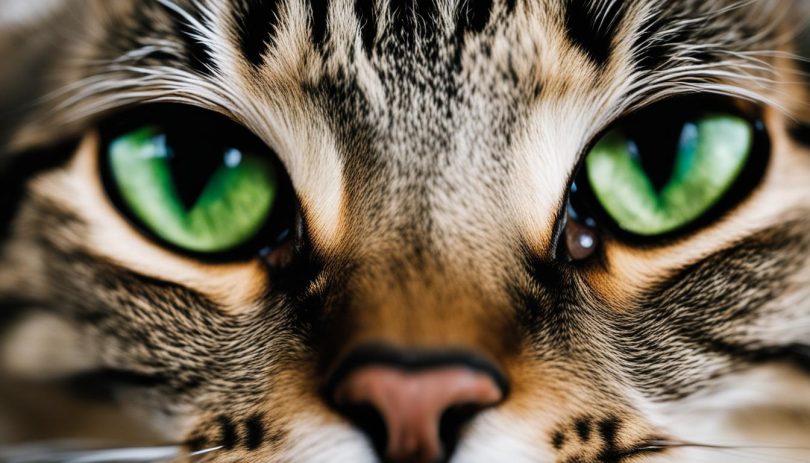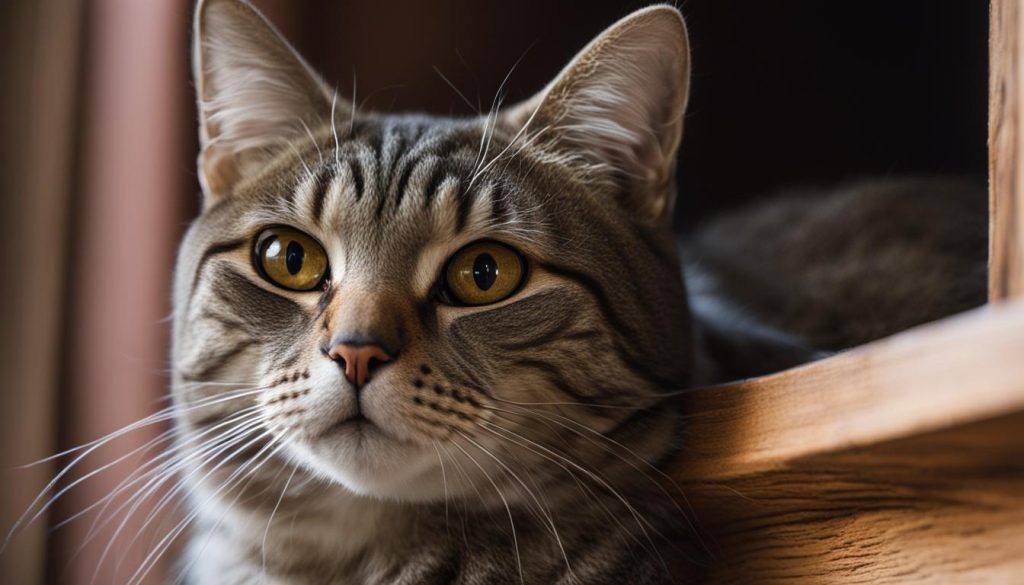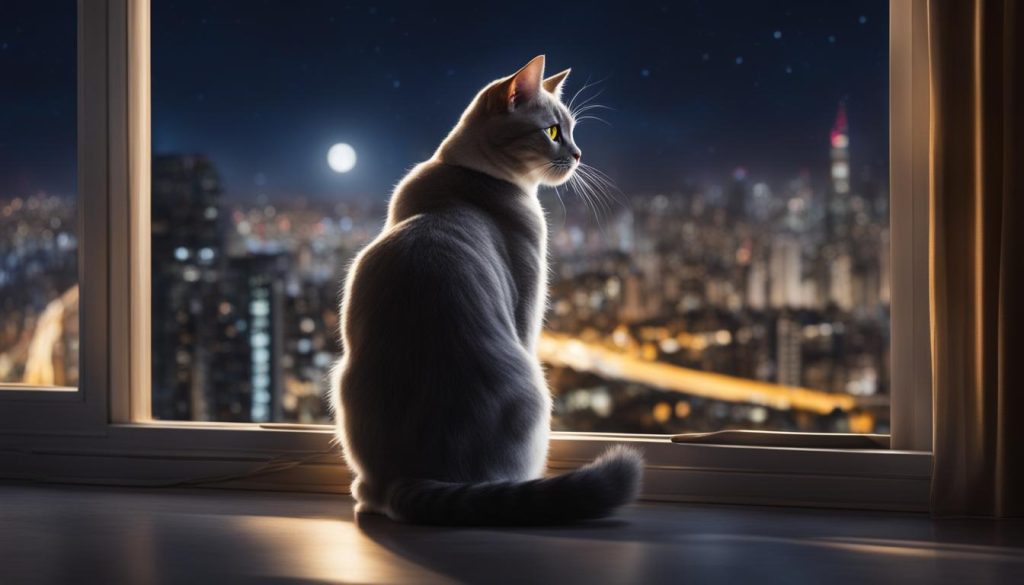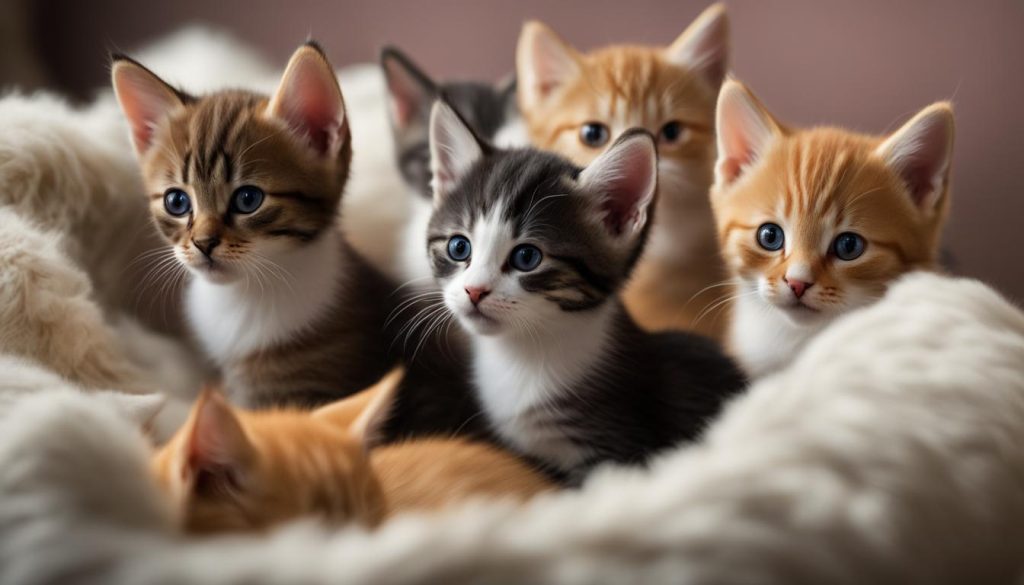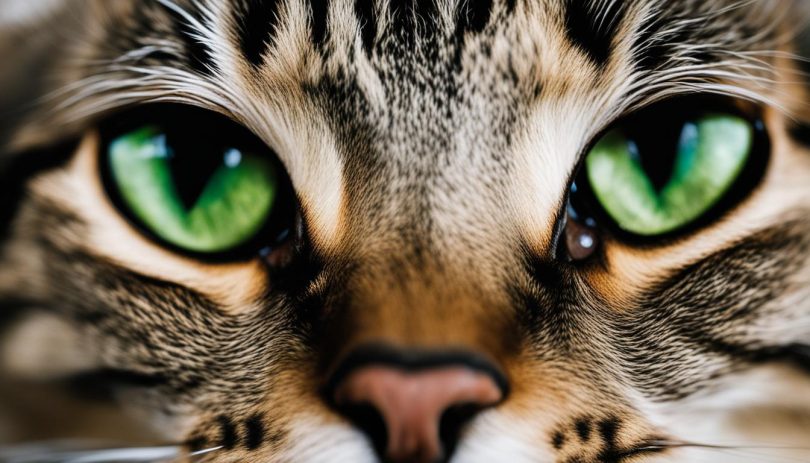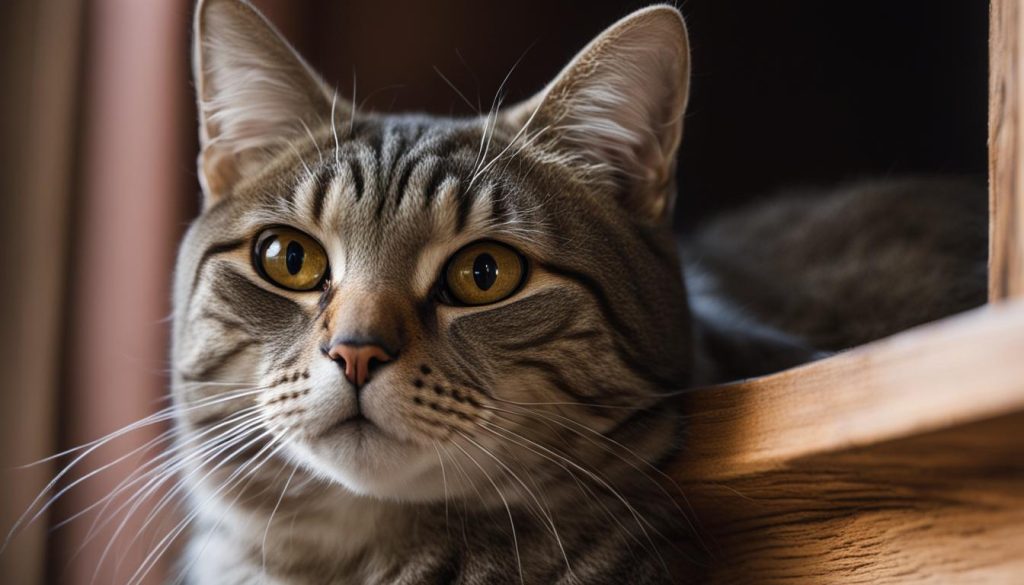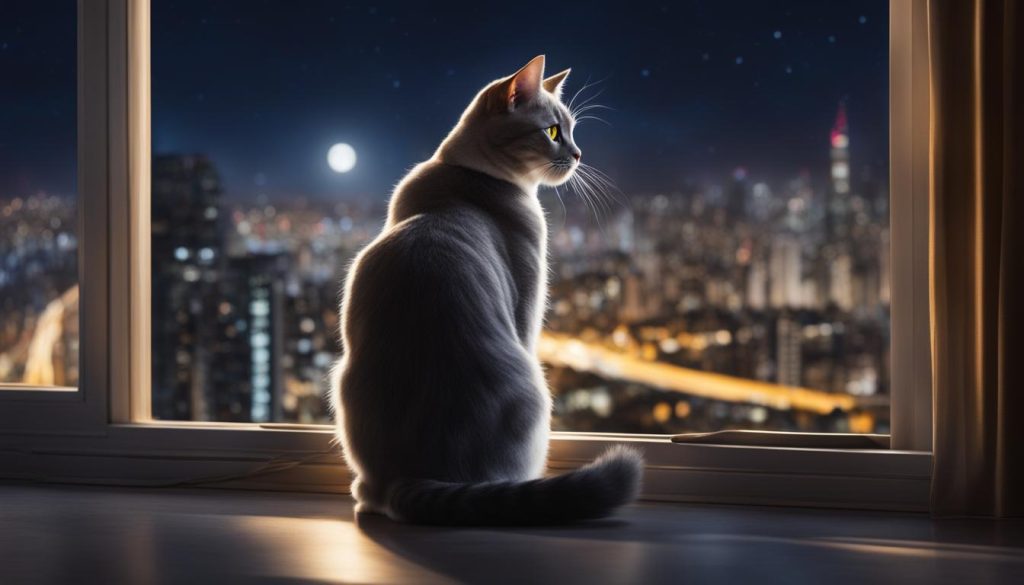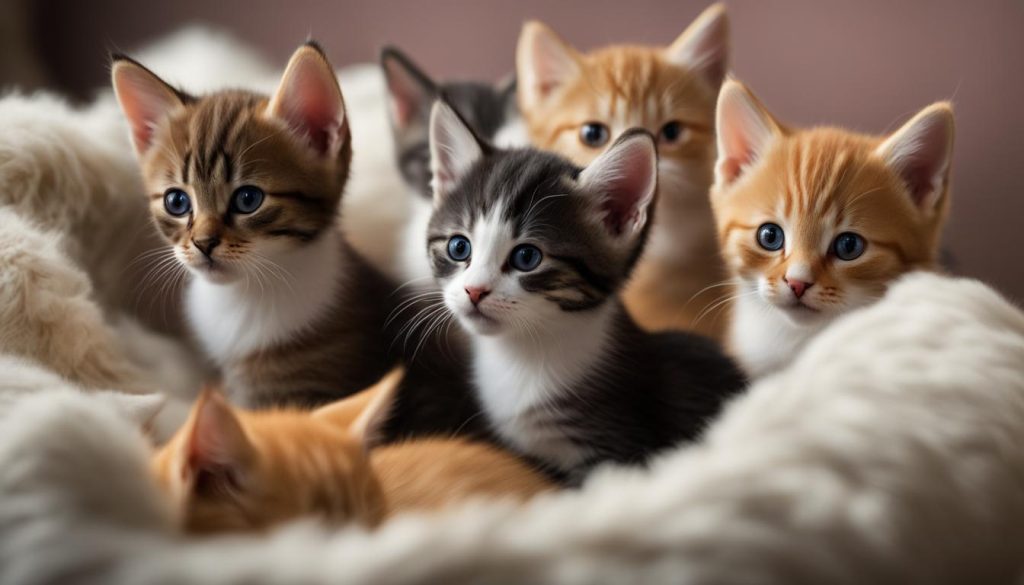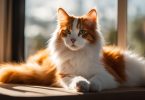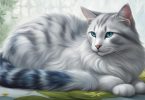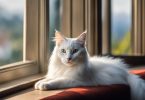European Shorthair cats are known for their fascinating personality traits, making them a favorite among cat enthusiasts. Understanding their temperament, behavior, and unique characteristics is key to forming a strong bond with these enchanting felines. Join me as we delve into the world of European Shorthair cats and explore what sets them apart.
Key Takeaways:
- The European Shorthair breed exhibits distinct personality traits that make them captivating companions.
- By decoding their behavior and understanding their temperament, cat lovers can better connect with European Shorthair cats.
- European Shorthair cats have unique communication styles, including meowing sounds and body language cues.
- Meowing sounds can convey various messages, such as hunger, affection, or distress.
- Observing their body language, such as tail position and ear orientation, can provide insights into their emotional state.
The Communication Style of European Shorthair Cats
European Shorthair cats have a unique communication style that allows them to express their emotions and needs. They use a combination of meowing sounds, body language, and facial expressions to convey their messages. When interacting with humans, European Shorthairs primarily use meows to communicate. Each type of meow has a specific meaning and can be used to call for attention, express hunger, or show affection. By understanding and interpreting their meowing sounds, cat owners can provide the necessary care and attention to their European Shorthair companions.
In addition to meows, European Shorthair cats also rely on body language cues to communicate. They use their tail position, ear orientation, and facial expressions to convey their emotional state. For example, a raised tail indicates a friendly greeting, while flattened ears may indicate fear or aggression. Observing their body language in conjunction with their meowing sounds can help cat owners better understand their European Shorthair’s needs and emotions, strengthening the bond between them.
To summarize, European Shorthair cats have a unique communication style that combines meowing sounds, body language, and facial expressions. By paying attention to their vocalizations and body cues, cat owners can effectively respond to their needs and establish a deeper connection with their European Shorthair companions.
The Importance of Understanding Cat Communication
Understanding the communication style of European Shorthair cats is essential for creating a harmonious relationship between humans and their feline friends. By recognizing and responding to their meowing sounds and body language cues, cat owners can provide a supportive and nurturing environment. This understanding also helps to address any potential issues or discomfort that the European Shorthair cat may be experiencing. By actively engaging with their communication style, cat owners can ensure the well-being and happiness of their European Shorthair companions.
Meowing Sounds and Their Meanings
The meowing sounds made by European Shorthair cats can provide valuable insights into their needs and emotions. By understanding the different types of meows and their meanings, cat owners can better meet the requirements of their feline companions and ensure their overall well-being.
European Shorthair cats use a wide range of meowing sounds to communicate various messages. Soft and content meows indicate relaxation and satisfaction, while louder and more persistent meows are a way for cats to seek attention, express hunger, or show affection. Urgent and heightened meows can indicate stress or distress, signaling that the cat may be in pain, scared, or anxious. On the other hand, warning meows with a deeper, aggressive tone can express dominance or hostility towards other animals or humans. Mating meows are high-pitched and loud, often accompanied by specific body language to advertise their availability to potential mates.
It is crucial for cat owners to pay attention to these meowing sounds and their meanings. By doing so, they can respond appropriately to their European Shorthair cat’s needs and ensure their happiness and comfort. If a cat consistently exhibits unusual or excessive meowing, it is advisable to consult with a veterinarian to rule out any underlying health issues.
| Meowing Sound | Meaning |
|---|---|
| Soft and content meows | Relaxation and satisfaction |
| Louder and persistent meows | Seeking attention, expressing hunger, or showing affection |
| Urgent and heightened meows | Stress or distress |
| Warning meows | Dominance or hostility towards other animals or humans |
| Mating meows | High-pitched and loud, accompanied by specific body language to attract potential mates |
The Role of Body Language in European Shorthair Cat Communication
When it comes to understanding European Shorthair cats, their body language plays a vital role in communication. Just like humans, cats express their emotions and needs through subtle physical cues, allowing us to interpret their intent and emotional state. By observing their tail position, ear orientation, and facial expressions, cat owners can gain valuable insights into their European Shorthair’s comfort level, stress levels, and overall well-being.
Table: European Shorthair Meowing Sounds and Their Meanings
| Meowing Sound | Meaning |
|---|---|
| Soft, content meows | Relaxation and satisfaction |
| Louder and persistent meows | Attention, food, or playtime |
| Urgent and heightened meows | Stress or distress |
| Warning meows with aggressive tone | Dominance or hostility |
| Mating meows | Advertisement of availability to potential mates |
The Influence of Breed on Meowing Sounds
When it comes to meowing sounds, European Shorthair cats have their own unique vocalizations that can be influenced by their breed. While breed plays a role, it is important to note that other factors, such as age, environment, and individual character, also contribute to the sounds they make. Understanding these meowing sounds can provide valuable insights into a European Shorthair’s needs and emotions.
Some cat breeds, like Siamese cats, are naturally more vocal and expressive. Their meows tend to be loud and demanding, often used to communicate their desire for attention or to express their hunger. On the other hand, breeds like Siberian cats may exhibit a broader range of meows, including softer and quieter vocalizations.
While breed can provide a general understanding of the meowing sounds a European Shorthair cat may make, it is essential to remember that each cat is an individual. Their meows can vary based on their unique traits and lineage. By paying attention to their specific meowing sounds, cat owners can better meet their European Shorthair’s needs and provide them with a happy and fulfilling life.
“Understanding these meowing sounds can provide valuable insights into a European Shorthair’s needs and emotions.”
The Development of Meowing Sounds in European Shorthair Kittens
As kittens, European Shorthairs rely heavily on meowing sounds to communicate their needs and emotions. Their meows serve as a way to connect with their mother and, as they grow older, with humans as well. Initially, kittens use meows to express their basic needs, such as hunger or discomfort. These initial meowing sounds are simple and straightforward. However, as they continue to interact with their environment and learn from their mother and human caretakers, their meows become more complex and diverse.
As European Shorthair kittens mature, their meows evolve to convey a range of emotions and desires. They may develop different types of meows to indicate specific needs or emotions, such as playful meows to express their desire for interaction or affectionate meows to show love and contentment. By observing and responding to their evolving meowing sounds, cat owners can better understand and meet the needs of their European Shorthair kittens.
It’s important to note that the development of meowing sounds in European Shorthair kittens is influenced by a variety of factors, including genetics, environment, and individual character. Each kitten may have a unique vocalization style that reflects their personality and temperament. Some kittens may have louder and more assertive meows, while others may have softer and more delicate meows. The key is to pay attention to the individuality of each European Shorthair kitten and respond accordingly to their specific vocalizations and needs.
| Development of Meowing Sounds in European Shorthair Kittens | Characteristics |
|---|---|
| Initial meowing sounds | Simple and straightforward, used to express basic needs |
| Evolving meows | Become more complex and diverse, convey a range of emotions and desires |
| Influencing factors | Genetics, environment, individual character |
| Unique vocalization style | Reflects personality and temperament, varies from kitten to kitten |
Understanding the development of meowing sounds in European Shorthair kittens is essential for their well-being and proper care. By paying attention to their evolving vocalizations and responding with care and love, cat owners can foster a strong bond and provide a nurturing environment for their kittens to thrive.
The Five Major Personality Types of Cats
When it comes to European Shorthair cats, understanding their personality type can help cat owners provide the best care and create a harmonious living environment. Just like humans, cats have unique personalities that influence their behavior, preferences, and temperament. Through my interactions with European Shorthair cats and research, I have identified five major personality types that can help cat lovers better understand their feline friends.
1. Human Cats:
- These cats thrive on human affection and enjoy being near their owners.
- They seek attention, cuddles, and companionship from their human caregivers.
- Human Cats are known for their loving and affectionate nature, often acting like lap cats.
2. Hunter Cats:
- Hunter Cats have a strong prey drive and enjoy engaging in hunting activities.
- They may display natural stalking behaviors and enjoy interactive play with toys.
- These cats need mental and physical stimulation to satisfy their natural instincts.
3. Cats’ Cats:
- Cats’ Cats find comfort in the company of other cats.
- They enjoy socializing and playing with their feline companions.
- These cats may display behaviors such as grooming, cuddling, or chasing other cats.
4. Cantankerous Cats:
- Cantankerous Cats have sensitive needs and value their independence.
- They may be more aloof and prefer their own space and solitude.
- These cats appreciate a calm environment and may be selective in their interactions.
5. Inquisitive Cats:
- Inquisitive Cats are curious and playful, always exploring their environment.
- They enjoy interactive toys, puzzles, and games that challenge their intelligence.
- These cats thrive in an enriched environment that stimulates their senses.
As every European Shorthair cat is unique, they may exhibit a combination of these personality types or lean more toward one specific type. Understanding your cat’s personality can help you tailor their environment, activities, and interactions to meet their specific needs and enhance their overall well-being.
By recognizing and respecting the personality traits of European Shorthair cats, cat lovers can create a stronger bond with their feline companions and provide them with a happy and fulfilling life.
Best Cat Breeds for the Indian Climate
When it comes to selecting a cat breed that can thrive in the Indian climate, there are several factors to consider. Heat tolerance, adaptability to apartment living, and overall comfort in warm temperatures are important aspects to take into account. While the European Shorthair is not specifically mentioned in this section, it is worth exploring other breeds that are known to do well in the Indian climate.
Here are some of the best cat breeds that can thrive in the Indian climate:
- Bombay Cat: Known for their sleek black coat and affectionate nature, Bombay cats can adapt well to the Indian climate.
- Himalayan Cat: With their long, luxurious coat, these cats are well-suited to cooler indoor environments, making them a good choice for apartment living in India.
- Siamese Cat: Siamese cats are known for their heat tolerance and adaptability, which makes them an excellent choice for the Indian climate.
- Rusty-Spotted Cat: This small, wild-looking cat is native to India and is well adapted to the country’s warm climate.
- Ragdoll Cat: Ragdolls have a calm and gentle temperament, making them an ideal indoor companion for Indian cat lovers.
- Birman Cat: Birmans are known for their silky fur and friendly nature, adapting well to different climates, including the Indian climate.
- Abyssinian: This breed has a short coat and is highly active, making them well-suited to the warmer temperatures in India.
- Oriental Shorthair: Orientals are known for their slender build and short coat, which helps them stay cool in hot climates.
- Tonkinese Cat: Tonkinese cats have a short coat and are known for being sociable and adaptable, making them a good choice for the Indian climate.
Choosing a cat breed that is well-suited to the Indian climate ensures that your feline companion can live comfortably and happily in their environment. It’s important to consider the specific needs and characteristics of each breed to find the perfect match for your home and lifestyle.
Table: Best Cat Breeds for the Indian Climate
| Breed | Main Characteristics |
|---|---|
| Bombay Cat | Sleek black coat, affectionate nature |
| Himalayan Cat | Long, luxurious coat, well-suited to cooler indoor environments |
| Siamese Cat | Heat tolerant, adaptable |
| Rusty-Spotted Cat | Small size, native to India |
| Ragdoll Cat | Calm, gentle temperament |
| Birman Cat | Silky fur, friendly nature |
| Abyssinian | Short coat, highly active |
| Oriental Shorthair | Slender build, short coat |
| Tonkinese Cat | Short coat, sociable, adaptable |
Choosing the right cat breed for the Indian climate not only ensures their physical well-being but also helps create a harmonious and enjoyable living environment for both you and your feline companion.
Conclusion
After exploring the fascinating world of European Shorthair cats, it’s clear that they possess a unique and captivating personality. Understanding their communication style, meowing sounds, body language, and breed characteristics can greatly enhance the bond between cat lovers and these enchanting felines.
European Shorthair cats have a diverse range of meowing sounds, each with its own meaning. By paying attention to their vocalizations, cat owners can better respond to their needs and ensure their well-being. Additionally, observing their body language cues, such as tail position and ear orientation, provides valuable insight into their emotional state.
While breed can influence a cat’s meowing sounds, factors like age, environment, and individual character also contribute. Each European Shorthair cat has its own unique voice and temperament, making them truly special companions. By decoding the European Shorthair personality, cat lovers can create a harmonious living environment and provide a fulfilling life for their feline friends.
Whether you have a European Shorthair or are considering adopting one, their distinct temperament, behavior, and traits make them wonderful additions to any home. By understanding and connecting with these enchanting cats, you can forge a deep and meaningful bond that will bring joy and companionship for years to come.
FAQ
What are the different types of meows that European Shorthair cats use to communicate?
European Shorthair cats use a wide range of meows to convey different messages, such as soft meows for relaxation, louder meows for attention, urgent meows for stress or distress, warning meows for dominance or hostility, and high-pitched meows for mating.
How can I understand the body language of my European Shorthair cat?
European Shorthair cats use tail position, ear orientation, and facial expressions to convey their emotional state. Raised tail signifies a friendly greeting, flattened ears can indicate fear or aggression. Observing their body language in conjunction with their meowing sounds provides a more accurate understanding of their intent and emotional state.
How has domestication influenced the communication style of European Shorthair cats?
Domestication has led to European Shorthair cats relying more on vocalizations, such as meows, to communicate with humans compared to wild cats who primarily rely on scent-marking and body language to interact with other cats.
Do different cat breeds have different meowing sounds?
Yes, each breed, including the European Shorthair, may have its own distinct meowing sounds influenced by their breed characteristics. Factors such as age, environment, and individual character also contribute to the unique voice of each European Shorthair cat.
How do European Shorthair kittens communicate with their owners?
European Shorthair kittens use meows to communicate their needs, such as hunger or discomfort, with their mother and humans. As they grow older, they develop different types of meows to express various needs or emotions.
What are the major personality types of cats, including European Shorthairs?
Cats, including European Shorthairs, can generally be categorized into five major personality types: Human Cats, Hunter Cats, Cats’ Cats, Cantankerous Cats, and Inquisitive Cats. Understanding the personality type of a European Shorthair cat can help cat owners cater to their specific needs and create a harmonious living environment.
Which cat breeds are better suited for the Indian climate?
Some of the best cat breeds for the Indian climate include the Bombay Cat, Himalayan Cat, Siamese Cat, Rusty-Spotted Cat, Ragdoll Cat, Birman Cat, Abyssinian, Oriental Shorthair, and Tonkinese Cat. These breeds offer a range of characteristics and traits that can thrive in the Indian environment, ensuring their comfort and well-being.
